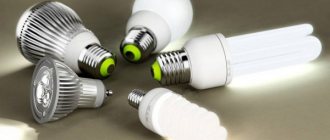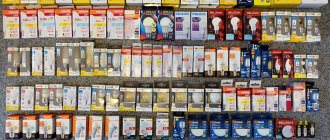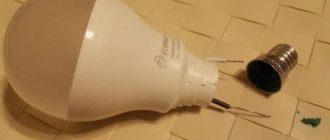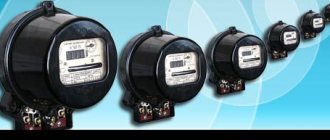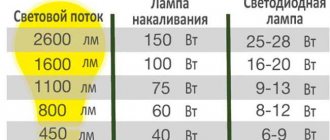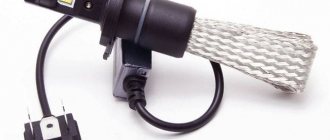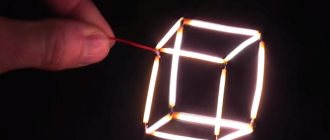Almost every manufacturer, one way or another, overestimates the service life of LED lamps. This is explained very simply - compared to conventional incandescent lamps, LED lamps are always much more expensive, so the buyer needs to be encouraged to spend money on this particular product. And then marketers calculated the two most serious factors that directly affect the buyer’s desire to purchase a new product - energy savings and a longer lamp life.
Marketers, of course, are smart guys, so it’s a good idea to figure out how things really are in order to protect yourself from unnecessary disappointments.
Service life: manufacturers' promises and realities
On the Internet you can find the average service life of any light-emitting diode (LED) lamp, regardless of the manufacturer – 50 thousand hours. That is, more than 2083 days or 5 years. But it is worth knowing that no real research has been conducted on this topic (at least in Russia), so it is not possible to confirm this tempting figure experimentally.
The service life of a typical incandescent lamp is about a thousand hours. Luminescent - from 6 to 10 thousand hours.
We also need to take into account our realities - with voltage drops, poor quality wiring and emergency shutdowns. And if we are talking about street lighting, then adverse weather conditions can also affect the service life of the lamps. In general, there are many factors, it is almost impossible to exclude them, so you should not hope for the declared service life of 5-7 years.
Typically, an LED lamp requires a standard voltage of 220 volts. But almost all of them will work at lower voltage. The maximum low and maximum voltage values for each lamp are indicated on the packaging.
And finally, a couple more tips.
- When buying an LED lamp, ask the seller about its production date. If the lamp was manufactured more than a year ago, you should inquire about another one;
- When purchasing, remove the lamp from the colorful packaging, carefully examine its appearance to see if there are any stains, smudges, color changes, etc. Shake the lamp near your ear to see if something is rattling inside. If there is something like that, then you should inquire about another lamp;
- We bought and brought an LED lamp home from the cold. Do not screw in the lamp or turn it on immediately. Let the lamp sit in the room for a couple of hours. The situation is similar for those who like to stay in a room cooled by air conditioning in the heat. Keep the LED lamp you brought from the heat for a couple of hours in the room where you are going to turn it on.
led 5 led lamp 18
Features of “burnout” of LED lamps
LED lamps have one unique property that cannot be ignored. Their service life is divided into effective and full.
An LED lamp does not burn out immediately like a regular light bulb - it simply loses brightness over time. At the same time, the luminous flux decreases.
The full service life of the lamp will be considered the entire time it operates until it completely fails. Effective - the period during which it dims by 30% of its original brightness.
A conscientious manufacturer should indicate both of these terms when labeling a product, but often gets by with indicating only the full service life, which, moreover, can be hypothetical, as mentioned above.
Therefore, do not rush to buy the lamp that, as the packaging promises, will work for 5-7 years. It is quite possible that it will work that long, but by the end of its “life” it will shine no brighter than a kerosene lamp. So it will be more profitable to find a product from a manufacturer who honestly indicates the period of effective operation of the lamp, after which the brightness will inexorably (albeit slowly) decrease.
The effective life of white LEDs is approximately 10 thousand hours, and red, blue, yellow and green - about 25 thousand hours. With an average use of home lighting of 6 hours per day, the human eye begins to notice a decrease in the brightness of the lamp after about 4 years of its use.
Another little secret when choosing an LED lamp is the warranty period. The smaller it is, the lower the quality of the product offered. You should not buy lamps whose manufacturer has indicated a warranty period of 1 year - this is done in order to avoid mass exchange of failed lamps. A two-year warranty is a sign of average quality, and from 3 to 5 years is a good product that will serve you for a long time.
Is it worth buying cheap Chinese lamps?
Many buyers are tempted by the low prices of Chinese products. However, buying such lamps contains many unpleasant pitfalls:
- No warranty. It is rare that an online seller provides a guarantee on the goods they sell. Even if the product is initially defective, it will be difficult to prove anything and exchange is not always possible.
- Exaggerated promises. Chinese-made products are often offered with tempting technical characteristics that are not confirmed in practice.
- Poor quality LEDs. Almost all Chinese-made LED light bulbs are offered without specifying a specific manufacturing company. Such products are assembled from cheap components and are often initially defective.
- Insufficient lighting spectrum. It is not recommended to use cheap lamps for home use. If you have already purchased such a device, it is better to install it for street lighting. Poor quality light negatively affects vision, especially children's vision.
- Low color rendering index. Low-quality LEDs produce insufficient luminous flux. The ability to perceive colors in this case is reduced many times over. This is an almost universal drawback of Chinese products.
- The presence of powerful pulsations. This figure should not be higher than 20%, which corresponds to a hundred flashes every second. When there are too many of them, the eyes quickly get tired, which adversely affects not only vision, but also the general condition of a person. Chinese LED lamps have a ripple rate of 30%.
- Bad reputation. Reviews of cheap electrical goods from China are most often negative.
The miser pays three times!
From the very beginning of the use of LED lamps, they began to be counterfeited. And since the original product was very expensive, and the Chinese “analogues” were several times cheaper, the demand for them was quite serious.
Only a few years have passed, prices for LED lamps have dropped significantly, but our eastern neighbors still continue to “send” counterfeit LED lamps to Russia. And they continue to buy them. Why shouldn't you do this?
- The quality of light from such a lamp can be completely unpredictable, which negatively affects health.
- The assembly of Chinese lamps always leaves much to be desired, and the most “harmless” thing that can happen during its use is that the plugs (automatic machine on the meter) will be knocked out or the chandelier will deteriorate.
- There is no service life in the case of counterfeit lamps; they can fail at any time.
Reasons for failure of incandescent lamps
Today, the average lifespan of an incandescent lamp is about 1,000 hours.
This is not very much for an electronic device. Moreover, you probably noticed that many light bulbs do not even last this long. What are the reasons for such a short life? Here are the main ones: Hard start. As you probably know from your school physics course, when a conductor is heated, its resistance increases, and when it cools, it decreases. For a light bulb, this law is very problematic, since the resistance of a cold spiral is 12 times lower than that of a heated one. This means that at the moment of switching on, a current flows through the device that is 12 times higher than the operating current (remember Ohm’s law: I = U/R)! This effect is called electric shock, and an ordinary light bulb that you screw into a chandelier or table lamp has no protection against it.
You've probably noticed that light bulbs most often burn out the moment they are turned on. This happens precisely because of their difficult start.
- Increasing the supply voltage. As the supply voltage increases, the temperature of the coil increases, which means it evaporates faster - after all, the nitrogen-argon mixture only protects tungsten from oxidation. As a result, the service life of the overheated coil becomes shorter, as it becomes thinner faster. At some point (usually the next time you turn it on), the spiral cannot withstand the current shock and burns out. How critical is the increase in supply voltage? You will be surprised, but if you increase the supply voltage by only 6% (from the nominal 220 this is only 10-12 volts), then the average service life of an incandescent lamp will be halved!
- Shocks and vibrations. A very pressing problem for portable devices and lighting devices operating on vehicles. The spiral itself is a rather fragile thing, and when heated literally to white heat, tungsten, like any other metal, loses its mechanical strength. It is enough to shake a table lamp or carrying case vigorously for the filament to break and the service life of the device to suddenly end. Designers solve the problem of increasing service life by shortening the length of the spiral and increasing the number of hangers. But all this is done to create special lighting devices, for example, automobile ones. Ordinary “apartment” light bulbs are practically not protected from this disaster.
- Light fixture malfunction. If the supply wires, socket or switch have poor contact, then the lighting device is constantly exposed to voltage surges, and therefore to current shocks. In this case, it can work out the service time of several hours measured by the manufacturer.
- Poor quality. This refers to the manufacturing quality of the device. Despite its relatively simple design, a light bulb is a technologically complex device that cannot be made “on your knees.” Nevertheless, some craftsmen (I won’t point a finger at the brothers from China, they are no more hacky than others, and lately even less) manage to make quite functional, at first glance, devices from nothing and it is not clear on what equipment. The average service life of such a device is 3-4 starts.
Not just for home
LED lamps are used not only for lighting apartments. They can be found in offices and on city streets. They are also successfully used in cosmetology. Therefore, it is worth saying a few words about the service life of “specialized” LED lamps and luminaires.
Armstrong-type ceiling lamps, consisting of several blocks of LEDs, are often used to illuminate offices, warehouses, shopping centers and other public buildings. Taking into account the fact that in such rooms the lamps work for more than 6 hours a day, the service life of the lamps is about 3-4 years, then they begin to lose their brightness.
The service life of street lamps and floodlights depends on operating conditions. Most manufacturers promise from 6 to 20 thousand hours of operation, but in fact the lamps do not always work that long due to their high sensitivity to elevated temperatures.
All about LEDs
What is the average lifespan of LEDs?
It is impossible to lump all types of LEDs into one pile and treat them equally.
The service life directly depends on the type of LED, the current supplied to it, cooling of the LED chip, the composition and quality of the crystal, layout and assembly as a whole. LEDs are said to be extremely durable. But it is not so. The more current passed through an LED during its service, the higher its temperature and the faster aging occurs. Therefore, the service life of high-power LEDs is shorter than that of low-power signal LEDs. Aging is expressed primarily in a decrease in brightness. When the brightness decreases by 30% or half, the LED must be replaced.
It is obvious, for example, that in LEDs with a power of 1 W (operating current 0.350 A) and more powerful, the heat generation is much greater than in LEDs of the “5 mm” type. LEDs designed for a current of 0.02 A. By luminous efficiency 1 pc. A 1 W LED replaces about 50 5 mm LEDs. but it also gets hotter. Therefore, LED assemblies with high-power LEDs require passive (mounting on an MCPCB board and heatsink) cooling.
According to our tests, average service life:
5 mm-LED and SMD-LED (produced by the best brands): • white up to 50,000 hours with a drop in luminous flux of up to 35% during the first 15,000 hours.
• blue, green up to 70,000 hours with a drop in luminous flux of up to 15% during the first 25,000 hours.
• red, yellow up to 90,000 hours with a slight drop in luminous flux.
HI-POWER LED from 1 W and above (produced by the best brands): • white up to 80,000 hours with a drop in luminous flux of up to 15% during the first 10,000 hours.
• blue, green up to 80,000 hours.
• red, yellow up to 80,000 hours.
Why do white LEDs have the shortest lifespan?
Unfortunately, no one has yet invented structures that emit white light. The basis of the white LED is the InGaN structure, emitting at a wavelength of 470 nm (blue color) and a phosphor (special composition) applied on top of it, emitting in a wide range of the visible spectrum and having a maximum in its yellow part. The human eye perceives a combination of this kind as white. The phosphor degrades the thermal characteristics of the LED, so its service life is reduced. Now world manufacturers are inventing new and new options for effective application of phosphor.
Most ultra-bright LEDs last between 50,000 and 80,000 hours. Is it a lot or a little?
50,000 hours is :
24 hours a day 5.7 years 18 hours a day 7.4 years 12 hours a day 11.4 years 8 hours a day 17.1 years
Do LEDs get hot?
Many people believe that LEDs practically do not heat up. So why do LED devices need a heat sink and what happens if there is no heat sink?
LEDs produce heat in the semiconductor junction. And the more powerful the LED, the more heat. Of course, indicator LEDs, such as car alarm sensors, do not get very hot. But they have little in common with super-bright LEDs. If powerful LEDs are combined into some kind of assembly, and even installed in a sealed housing, then the heating becomes significant.
And if heat is not removed, the semiconductor junction overheats, which changes the characteristics of the crystal, and after some time the LED may fail. So it is very important to strictly control the amount of heat and ensure efficient heat dissipation. The thermal characteristics of our devices are calculated already at the design stage, which eliminates any problems in operation.
How does the LED react to rising temperatures?
Speaking about the temperature of the LED, it is necessary to distinguish between the temperature on the surface of the crystal and in the region of the pn junction. The service life depends on the first, the light output depends on the second. In general, as the temperature of the pn junction increases, the brightness of the LED decreases because the internal quantum efficiency decreases due to the influence of lattice vibrations. This is why good heat dissipation is so important.
The decrease in brightness with increasing temperature is not the same for LEDs of different colors. It is larger for AlGalnP and AeGaAs LEDs, that is, red and yellow, and smaller for InGaN, that is, green, blue and white.
What is the difference between a full-color RGB LED and a single-color one?
In a full-color LED, independent crystals of three emission colors (R+G+B) are installed on one substrate, and a monochrome LED contains crystal(s) of any one emission color.
How to adjust the brightness of the LED?
The brightness of LEDs can be very well adjusted, but not by reducing the supply voltage - this is something that cannot be done - but by the so-called pulse-width modulation (PWM) method, which requires a special control unit (in reality, it can be combined with the power supply and converter, as well as with an RGB matrix color control controller).
The PWM method consists in the fact that not a constant, but a pulse-modulated current is supplied to the LED, and the signal frequency should be from hundreds to thousands of hertz, and the width of the pulses and pauses between them can vary. The average brightness of the LED becomes controllable, while at the same time the LED does not go out.
What is the quantum efficiency of an LED?
Quantum yield is the number of light quanta emitted per recombined electron-hole pair. A distinction is made between internal and external quantum efficiency. Internal - in the pn junction itself, external - for the device as a whole (after all, light can be lost “along the way” - absorbed, scattered). The internal quantum efficiency for good crystals with good heat dissipation reaches almost 100%, the record external quantum efficiency for red LEDs is 55%, and for blue LEDs - 35%. External quantum efficiency is one of the main characteristics of LED efficiency.
What LED manufacturing technologies exist today?
As for growing crystals, the main technology is metal-organic epitaxy. This process requires particularly pure gases. Modern installations provide for automation and control of the composition of gases, their separate flows, and precise control of the temperature of gases and substrates. The thicknesses of the grown layers are measured and controlled ranging from tens of angstroms to several microns. Different layers must be doped with impurities, donors or acceptors, to create a pn junction with a high concentration of electrons in the n region and holes in the p region.
In one process, which lasts several hours, structures can be grown on 6–12 substrates with a diameter of 50–75 mm. It is very important to ensure and control the uniformity of structures on the surface of the substrates. The cost of installations for the epitaxial growth of semiconductor nitrides, developed in Europe (by Aixtron and Thomas Swan) and the USA (Emcore), reaches $1.5–2 million. The experience of different companies has shown that it is possible to learn how to produce competitive structures with the necessary parameters using such an installation in a period of one to three years. This is a technology that requires a high production culture.
An important stage of the technology is the planar processing of films: their etching, creation of contacts to the p- and p-layers, coating with metal films for contact leads. A film grown on a single substrate can be cut into several thousand chips with sizes ranging from 0.24x0.24 to 1x1 mm2.
The next step is to create LEDs from these chips. It is necessary to mount the crystal in the housing, make contact leads, and produce optical coatings that brighten the surface for outputting radiation or reflect it. If it is a white LED, then you need to apply the phosphor evenly. It is necessary to provide heat removal from the crystal and the case, to make a plastic dome that focuses the radiation into the desired solid angle. About half the cost of an LED is determined by these high technology steps.
The need to increase power to increase luminous flux has led to the fact that the traditional form of a packaged LED is no longer satisfactory to manufacturers due to insufficient heat dissipation. It was necessary to bring the chip as close as possible to the heat-conducting surface. In this regard, traditional technology and the somewhat more advanced SMD technology (surface montage details) are being replaced by the most advanced chip on board technology. An LED manufactured using SOV technology is shown schematically in the figure.
LEDs made using SMD and COB technologies are mounted (glued) directly onto a common substrate, which can act as a radiator - in this case it is made of metal. This is how LED modules are created, which can have a linear, rectangular or round shape, be rigid or flexible, in short, designed to satisfy any whim of the designer. LED lamps with the same base as low-voltage halogen lamps are also appearing, designed to replace them. And for powerful lamps and spotlights, LED assemblies are made on a massive radiator.
LED assemblies used to have a lot of LEDs. Now, as power increases, there are fewer LEDs, but the optical system that directs the light flux to the desired solid angle plays an increasingly important role.
Where are LEDs used today and what are their prospects?
It is advisable to use LED lighting in cases where high reliability is required, where maintenance of a lighting installation is too expensive and requires special equipment or the work of climbers, where it is necessary to use color-dynamic solutions, where an energy-efficient solution is required, for example, when powered by a variety of generators.
The other side of the coin: LED lamps are ideal for dim but effective lighting. This particular example is 90% more energy efficient than the smallest 15 W halogen light bulbs.
Every year, the light output and efficiency of LEDs increases by 30-50%. As of 2008, LED lamps are already more often used than lamps in architectural, decorative, landscape, underwater lighting, holiday illumination, show business, as well as in special applications - medicine and plant growing, for example.
In the foreseeable future, most likely, LEDs will replace lamps in emergency lighting of public places - entrances of residential buildings, illuminated signs, etc. And also in transport - on planes, trains, cars. And then, as technology develops and production becomes cheaper, it will come to night lighting of roads and streets. All this will provide significant savings in energy resources on a national scale.
Which global companies produce LEDs?
List of leading manufacturers in the world:
— “CREE” (USA); — “Osram” (Germany); — “Lumieleds Luxeon” (USA); — “Seoul Semiconductor” (South Korea); — “Prolight Opto” (Taiwan); — “Nincha” (Japan); — “Edixeon” (Taiwan); — “LedEngin” (USA); — “Svetlana-Optoelectronics” (Russia); — NPO “RoSAT” (Russia).
Every year, the luminous flux of the most productive LED of each of the world brands increases steadily by 20-30%. The cost of 100 lm of luminous flux falls by 10-15% per year, and hence the stable annual drop in prices for LED lighting devices.
The price of an LED device, of course, depends on the cost of the LEDs themselves. In the mass production of lighting products, LEDs constitute the largest line item in the budget for the production of LED devices.
How to extend service life
In order for the lamp to work longer, it is necessary to ensure that the heat generated by it is constantly dissipated, preventing “thermal degradation” of the LED. The very design of such a lamp (if it is of high quality) already provides for this process, and the owners of the device are left with only basic rules of care, which any housewife can easily cope with.
- Lamps must be regularly wiped from dust and even vacuumed. At the same time, it is strictly not recommended to use any detergents that can damage the lamp and even cause it to fail.
- All manipulations must be carried out only with the lamp turned off!
- LED strips should not be glued directly to wallpaper or furniture; it is better to use an aluminum profile for this purpose, which will remove the “excess” heat.
- If LED lamps in a public or industrial area constantly overheat and deteriorate, then it would be a good idea to contact any company that installs such lamps. Our specialists will help provide your lamps with high-quality heat dissipation and reduce the cost of purchasing lamps.
Taking into account all of the above, we can conclude: the service life of an LED lamp will almost always be less than what advertising and some manufacturers promise us. On average, it is approximately 3 years, but it depends on many factors that we have already told you about. And simple rules for caring for LED lamps will help extend their service life and avoid losing money.
Phosphor degradation
In an LED, phosphor degradation is determined mainly by temperature. After all, the phosphor is usually applied directly to the crystal, which heats up quite strongly. Other factors influencing the phosphor are not so significant. For effective heat dissipation, it is necessary to provide air access to the radiator, for example, like the Mini 300 LED from Royal Philips Electronics (Fig. 3.).
Rice. 3. Mini 300 LED from Royal Philips Electronics
Degradation of the phosphor leads not only to a decrease in the brightness of the LED, but also to a change in the shade of its glow. With severe degradation of the phosphor, a blue tint of the glow is clearly visible. This is due both to a change in the properties of the phosphor and to the fact that the crystal’s own radiation begins to dominate in the spectrum.
How to convert base fluorescent lamps into LED lamps
There are two options for modifying such a light bulb into an LED one:
- use of diode strip segments;
- Compact lamp with bright LEDs.
Conversion for LED strip
Materials for conversion and connection diagram:
Detailed video instructions for the modification:
For compact tabletop solutions, you can convert a fluorescent lamp to an LED lamp as follows. Unlike the previous option, this design provides a directional luminous flux and is ideal for illuminating the workplace. Diodes can be used at 0.5 or 1 W. Then the final brightness will be 350Lm or 700Lm, respectively.
To power the structure, you can use any 12V 2A power supply if you connect all the LEDs in parallel, or a 5V 2A mobile phone charger when connected in three parallel lines.
Power drivers for energy-saving light bulbs are not suitable for LEDs, so we can safely unsolder the wires going to the base from them, and send the boards themselves for further processing.
The modern small-sized table lamp, which is shown in the photograph, with a light source installed in it in the form of a fluorescent U-shaped compact lamp, worked for several years and failed.
According to the owner of the table lamp, recently, when the lamp was still working, an unpleasant odor was coming from its base.
Opening the base of the lamp immediately showed what the problem was. The insulation in one of the windings of the ballast device was burnt. Obviously, due to overheating or poor quality of insulation of the winding wire of the coil, a short circuit occurred between the turns, which provoked the heating of the winding to a high temperature and the final failure of the ballast device.
I didn’t want to bother with rewinding the coils, and it was almost impossible to find a ready-made ballast device for replacement, especially since its type was unknown. Therefore, I decided to remake the table lamp in a modern way - install LEDs instead of a fluorescent lamp, and replace the ballast device with an electronic driver, especially since everything for such a remodel was at hand.
What is consumer goods?
You've probably noticed that the same light bulb is sold by several manufacturers under different names and markings. Often, such LED lamps are purchased from one factory, which has several production lines.
Thanks to the rise in the dollar exchange rate, the struggle for markets intensified, and the purchasing power of the population decreased. You have to fight for the viability of a business by any means, including dishonest ones. Manufacturers use various cost reduction options:
- overstating;
- installation of worse LEDs, lower resource and quality;
- reducing the amount of metal on the radiator;
- The plastic is of low quality, sometimes it smells strongly of plastic;
- The driver is simplified.
What should be the optimal power factor?
| Power factor value | High | good | Satisfactory | Low | Bad |
| cos φ | 0,95..1 | 0,8..0,95 | 0,65..0,8 | 0,5..0,65 | 0..0,5 |
As mentioned above, the higher the coefficient value, the more efficiently the lamp operates. For example, the cosine φ for DRL lamps with an uncompensated ballast is only 0.5, and with a compensated choke it is 0.85. This suggests that from 15 to 50% of the electricity used by DRL lamps is wasted.
LED lamps have the highest power factor. According to the requirements of the Ukrainian standard, LED lamps with cos φ 0.9...1 must be used for lighting.
The use of lighting fixtures with a high power factor allows you to:
- use electricity economically and efficiently;
- reduce the load on the electrical network;
- increase the quality of light.
Technical aspects of installing LEDs instead of halogens
The difficulty in switching from halogen lamps to diodes lies in modifying the power circuit. The power supply for halogen sources provides the voltage required for LEDs at 12 Volts, but does not stabilize it. Without stabilization, the LEDs will flicker, causing eye discomfort that is harmful to health.
You can replace the power supply in several ways:
- Complete replacement of power supplies. Transformers from the chandelier body are replaced with DC converters or LED drivers.
- The simplest option is to replace halogen devices with diodes with installed rectifiers that operate at the same voltage. In this case, replacement of power supplies is not carried out; it is enough to simply install diodes in place of the halogens. An important disadvantage of the method is low illumination due to voltage drop; brightness can be increased with lamps of higher power.
- Selection of LED lamps that operate on 220 Volts. Such sources are connected in parallel from the household network. Auxiliary elements will require step-down transformers. If the lamp operated on 12-volt halogen lamps, and instead of them LEDs with a voltage of 220 V are installed, then the connecting cables will need to be replaced.
The first method is the most reliable and safe, but it is also the most labor-intensive and expensive.
If you use a remote control to operate the chandelier, then with a complete transition to LEDs, it will not be able to control the lamp. This is due to low power consumption.
Application of LED strips
Car lighting. The bottom, which will require only five meters of tape. Interior, wheels, rims, trunk, speeding up the search for the right thing. Glove compartment, dashboard, door handles, pedals and floor mats. Such lighting can last for a long time if it is mounted in a metal profile. Insensitive to temperature fluctuations. The 12 volt voltage makes it safe. Installation does not require highly qualified specialists, when anyone can do it themselves. The choice of colors and shades is enormous. The figure is 17 million. By controlling the remote control or program, they change the color, the shimmer of light, the speed of alternation of brightness and other special effects, without violating traffic safety on the road.
Curtain lighting. CD tape is flexible and easily attached to the surface of any material. For fabric curtains, tulle, nylon, tapestry, blinds or roller blinds. Using the RGB controller control panel, curtains are selected or programmed with backlighting. It is safe to arrange such a design. Low power tapes do not heat up. Synthetic materials are not damaged. Service life less than 100 thousand hours. The backlight is economical, it can be compared with a 25 W incandescent lamp.
Window decoration. The basis for use is the ability to set the required illumination and choose the color of the stream. It is taken into account that each product or food product is highlighted in a certain color. For example, the buyer is impressed by ice cream under blue light, and confectionery delicacies under yellow light. Under LED radiation, glass and crystal sparkle, jewelry located at different angles or in a scattering flux flickers. Backlighting is used in refrigerators and attractive wine shelves. This method does not harm the quality of the goods, products, is safe and economical.
Ceiling lighting. Application helps to update and instantly transform the interior of a room according to your mood at no cost. Visually adjust the height of the room, giving a real feeling of spaciousness and natural light. The flexible tape is pliable for installation in recesses and easily copies the configuration of different shapes. The service life is about ten years. Does not require special maintenance; they do not fail and cannot be replaced with new units and elements.
Main advantages of LED strips
- High reliability.
- Environmentally friendly.
- Easy to attach LED strips to a prepared surface.
- Low operating costs, given the ratio of light flux to cost.
- LED strips have a longer service life compared to well-known lighting lamps. At optimal temperature conditions it works for over 30 thousand hours.
- It is possible to increase the luminous flux in proportion to the length of the tape, avoiding overheating of the constituent elements.
- The design flexibility allows for a variety of design projects.
- Small dimensions.
- Allows adjustment of color tone and brightness.
- Safety of use.
- No pulsation.



